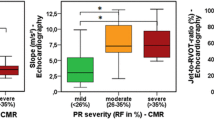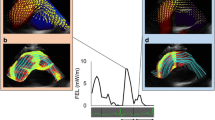Abstract
Background
Pulmonary regurgitation is a common finding in patients after correction of tetralogy of Fallot (TOF). Right ventricular impairment and even ventricular arrhythmia have been ascribed to pulmonary valve insufficiency (PI), which is therefore an important issue in follow-up examinations.
Objective
To compare PI measured by echocardiography (ECHO) with data provided by cardiac MRI (CMR).
Materials and methods
We studied 54 selected patients (18 female; median age 14.0 years, range 3.8–53.4 years) after surgical correction of TOF. To quantify pulmonary regurgitant fraction (PRF) by CMR, flow velocity mapping was performed. On Doppler ECHO, length, width and localization of regurgitant flow was measured. The severity of PI was categorized as mild, moderate or severe and compared to the data obtained by CMR.
Results
On CMR the mean PRF was 29.2 ± 13.4%. Patients with a transannular patch had a significantly higher PRF (39.9 ± 11.6%) than patients with an intact annular ring (23.6 ± 11.4%). Differentiation by Doppler ECHO between the categories mild, moderate and severe PI was confirmed by significant differences in PRF measured by CMR (mild vs. moderate P < 0.04; moderate vs. severe P < 0.014; mild vs. severe P < 0.001). Furthermore, PRF correlated with right ventricular end diastolic volume index (r = 0.45, P < 0.01) and right ventricular end systolic volume index (r = 0.39, P < 0.01).
Conclusion
Doppler ECHO can estimate the severity of PI after repair of TOF with acceptable results compared to CMR flow measurement. In univariate analysis there is only a weak influence of PRF on right ventricular volume.





Similar content being viewed by others
References
Reddy VM, Liddicoat JR, McElhinney DB et al (1995) Routine primary repair of tetralogy of Fallot in neonates and infants less than three months of age. Ann Thorac Surg 60:S592–S596
Hennein HA, Mosca RS, Urcelay G et al (1995) Intermediate results after complete repair of tetralogy of Fallot in neonates. J Thorac Cardiovasc Surg 109:332–342, 344; discussion 342–343
Abd El Rahman MY, Abdul-Khaliq H, Vogel M et al (2000) Relation between right ventricular enlargement, QRS duration, and right ventricular function in patients with tetralogy of Fallot and pulmonary regurgitation after surgical repair. Heart 84:416–420
Rebergen SA, Chin JG, Ottenkamp J et al (1993) Pulmonary regurgitation in the late postoperative follow-up of tetralogy of Fallot. Volumetric quantitation by nuclear magnetic resonance velocity mapping. Circulation 88:2257–2266
Fogel MA, Rychik J (1998) Right ventricular function in congenital heart disease: pressure and volume overload lesions. Prog Cardiovasc Dis 40:343–356
Norgard G, Gatzoulis MA, Moraes F et al (1996) Relationship between type of outflow tract repair and postoperative right ventricular diastolic physiology in tetralogy of Fallot. Implications for long-term outcome. Circulation 94:3276–3280
Grothoff M, Spors B, Abdul-Khaliq H et al (2006) Pulmonary regurgitation is a powerful factor influencing QRS duration in patients after surgical repair of tetralogy of Fallot: a magnetic resonance imaging (MRI) study. Clin Res Cardiol 95:643–649
Li W, Davlouros PA, Kilner PJ et al (2004) Doppler-echocardiographic assessment of pulmonary regurgitation in adults with repaired tetralogy of Fallot: comparison with cardiovascular magnetic resonance imaging. Am Heart J 147:165–172
Snider AR, Serwer GA, Ritter SB (1997) Echocardiography in pediatric heart disease. Elsevier, Oxford
Bryant DJ, Payne JA, Firmin DN et al (1984) Measurement of flow with NMR imaging using a gradient pulse and phase difference technique. J Comput Assist Tomogr 8:588–593
Gutberlet M, Boeckel T, Hosten N et al (2000) Arterial switch procedure for D-transposition of the great arteries: quantitative midterm evaluation of hemodynamic changes with cine MR imaging and phase-shift velocity mapping – initial experience. Radiology 214:467–475
Lotz J, Meier C, Leppert A et al (2002) Cardiovascular flow measurement with phase-contrast MR imaging: basic facts and implementation. Radiographics 22:651–671
Cullen S, Celermajer DS, Franklin RC et al (1994) Prognostic significance of ventricular arrhythmia after repair of tetralogy of Fallot: a 12-year prospective study. J Am Coll Cardiol 23:1151–1155
Gatzoulis MA, Balaji S, Webber SA et al (2000) Risk factors for arrhythmia and sudden cardiac death late after repair of tetralogy of Fallot: a multicentre study. Lancet 356:975–981
Bogren HG, Klipstein RH, Mohiaddin RH et al (1989) Pulmonary artery distensibility and blood flow patterns: a magnetic resonance study of normal subjects and of patients with pulmonary arterial hypertension. Am Heart J 118:990–999
Kondo C, Caputo GR, Masui T et al (1992) Pulmonary hypertension: pulmonary flow quantification and flow profile analysis with velocity-encoded cine MR imaging. Radiology 183:751–758
Mohiaddin RH, Paz R, Theodoropoulos S et al (1991) Magnetic resonance characterization of pulmonary arterial blood flow after single lung transplantation. J Thorac Cardiovasc Surg 101:1016–1023
de Ruijter FT, Weenink I, Hitchcock FJ et al (2002) Right ventricular dysfunction and pulmonary valve replacement after correction of tetralogy of Fallot. Ann Thorac Surg 73:1794–1800; discussion 1800
Babu-Narayan SV, Kilner PJ, Li W et al (2006) Ventricular fibrosis suggested by cardiovascular magnetic resonance in adults with repaired tetralogy of Fallot and its relationship to adverse markers of clinical outcome. Circulation 113:405–413
Oosterhof T, Mulder BJ, Vliegen HW et al (2005) Corrected tetralogy of Fallot: delayed enhancement in right ventricular outflow tract. Radiology 237:868–871
Acknowledgements
This work was supported in part by a grant of the Federal Ministry of Education and Research (BMBF) Competence Network for congenital heart disease.
Author information
Authors and Affiliations
Corresponding author
Rights and permissions
About this article
Cite this article
Grothoff, M., Spors, B., Abdul-Khaliq, H. et al. Evaluation of postoperative pulmonary regurgitation after surgical repair of tetralogy of Fallot: comparison between Doppler echocardiography and MR velocity mapping. Pediatr Radiol 38, 186–191 (2008). https://doi.org/10.1007/s00247-007-0691-y
Received:
Revised:
Accepted:
Published:
Issue Date:
DOI: https://doi.org/10.1007/s00247-007-0691-y




